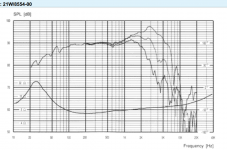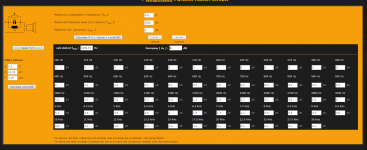Hi All. I just picked up these speakers last night. They are custom made with inner dimentions of 26.5"H x 9.5"W x 9.5"D. the woofer is the Scan Speak 21w/8554 8" with Kevlar Cone and the tweet is the Vifa but I don't know the model. I can't find a pic of the tweet with the same hole pattern as mine. Anyway, they are sealed cabs and the bass and lower midrange is rather bloated sounding. What causes bloated sound and how can I fix it. I found the woofs for sale in a couple places for $230-$260 so they "should" sound good.
An externally hosted image should be here but it was not working when we last tested it.
No on both counts....however, the bloating seems to go way beyound bounding issues or amp choice.
Biwireable? Check polarity?
I'm trying to think of things before you have to fiddle with the crossover.
I'm trying to think of things before you have to fiddle with the crossover.
Apparntly, they are set up for bi-amping but not wired that way. The tweet reostat is not hooked up either. I will dig into the crossover tomorrow to see what is in there. According to WinISD, it is a good size box, but might be even better (deeper bass) if I ported them.
What about foam surround, how does it feel like, soft?
Measure the TS parameters. XO filter can be anything
between excellent and total failure.
Measure the TS parameters. XO filter can be anything
between excellent and total failure.
Were your previous speakers smaller? Maybe these ones go down lower and are uncovering some issues with room modes. That is a pretty big box so I wouldn't expect a resonant peak in the bass output.
You might also like to take a look inside and check the cabinet has been properly stuffed. You never know with a DIY project, maybe the previous owner preferred the sound with no fill.
You might also like to take a look inside and check the cabinet has been properly stuffed. You never know with a DIY project, maybe the previous owner preferred the sound with no fill.
I don't think it is a box issue. Here is a screenshot of the woof in a sealed and vented box. My cabs are sealed and this speaker is much more suited to a vented box. While I'm watching the bowl games today, I'll tear into these speakers to see whats going on.
Attachments
OK, here is the problem!!! Yes, the cabs should be ported and I will do that, but the bigger issue is that there is an 8db bump starting at 1khz up to 3.5khz AND the crossover is a Dayton prebuilt that crosses at 3.5khz!!!
I did a WT3 test on the tweet and the low end was at 750hz so I am thinking need to build a 3rd order crossover for 1khz for starters.
Check my thinking but I think I right. Ideas???
I did a WT3 test on the tweet and the low end was at 750hz so I am thinking need to build a 3rd order crossover for 1khz for starters.
Check my thinking but I think I right. Ideas???
Attachments
djn,
scopeboy suggested a very reasonable detail which by some people
is overlooked, yet I see no reply from you.
My idea is, your are right about XO filter, it should be revised
with measurement gear. You are probably looking at a combination
of thin sounding bass driver being in a sealed box which does not
really work satisfactorily, probably not enough stuffing inside causing
FR anomaly (255 Hz for inner H, 712 Hz for W and D) together with
floor bounce and the said XO filter which doesn't help in any way to
sound great. I wouldnot cross at 1 kHz.
Do I need to stress that I'm mostly guessing?
scopeboy suggested a very reasonable detail which by some people
is overlooked, yet I see no reply from you.
My idea is, your are right about XO filter, it should be revised
with measurement gear. You are probably looking at a combination
of thin sounding bass driver being in a sealed box which does not
really work satisfactorily, probably not enough stuffing inside causing
FR anomaly (255 Hz for inner H, 712 Hz for W and D) together with
floor bounce and the said XO filter which doesn't help in any way to
sound great. I wouldnot cross at 1 kHz.
Do I need to stress that I'm mostly guessing?
I would think an off the shelf filter will have to strike lucky with those drivers.
Dayton Audio XO2W-3.5K 2-Way Speaker Crossover 3,500 Hz
Looks like 4.7uF bass shunt. For all that, 1.2mH and 10uF shunt looks reasonable.
Audiocostruzioni - Il Portale dell'alta fedelt amatoriale
The Scan Speak 21w/8554 is a low inductance driver, so that explains the midrange peak. The bass Zobel is around a mere 4.7uF/6.8R.
Impedance Equalization (L-Pad) Circuit Designer / Calculator
Most folks are doing reflex and second order negative polarity filters here time aligned:
faktiskt.se • Visa tråd - Bygge med mätningar! SS21W/8554 (utan -00) och SS2905/9000
I would think the crossover can be tuned by ear. 2.5-3kHz. But for me, it's saying third order bass and tweeter electrically. There is something to be said for putting some inductance back in front of the bass to get a tidier rolloff around 3kHz.
Dayton Audio XO2W-3.5K 2-Way Speaker Crossover 3,500 Hz
Looks like 4.7uF bass shunt. For all that, 1.2mH and 10uF shunt looks reasonable.
Audiocostruzioni - Il Portale dell'alta fedelt amatoriale
The Scan Speak 21w/8554 is a low inductance driver, so that explains the midrange peak. The bass Zobel is around a mere 4.7uF/6.8R.
Impedance Equalization (L-Pad) Circuit Designer / Calculator
Most folks are doing reflex and second order negative polarity filters here time aligned:
faktiskt.se • Visa tråd - Bygge med mätningar! SS21W/8554 (utan -00) och SS2905/9000
I would think the crossover can be tuned by ear. 2.5-3kHz. But for me, it's saying third order bass and tweeter electrically. There is something to be said for putting some inductance back in front of the bass to get a tidier rolloff around 3kHz.
Hi All. I want to mention that when I took the drivers out last night, I found all interior walls covered in acoustic foam and some stuffing above and below the woof. Also, the wall thickness of the cab is 1.5" not the typical 3/4". I do have an active crossover but only one amp at the moment. I agree about the notch filter which I've never played with so now is the time!!! I am also going to measure the speaker as is with the tweet disconnected, then take out the tweet and make a plate to take it's place that will have an adjustable length port on it. That way I can get the port right before cutting into these beautiful cabs.
Why are you using a manufacturer's measurement of FR
and dcr of the driver instead of a real FR measurement of the
driver in your box and its impedance?
Having both of these measurements you could simulate
a solution and a new XO filter.
and dcr of the driver instead of a real FR measurement of the
driver in your box and its impedance?
Having both of these measurements you could simulate
a solution and a new XO filter.
For long as the cabinet stays sealed, you might try fiberglass or a full polyfill internal damping. The foam is usually selected as a heavy tradeoff in midrange damping performance to keep the major internal volume open only when reflex porting is used. Compared to a fairly tight stuffing, the foam doesn't do a whole lot.
PCD7 has software to predict a notch filter, but more often than not, you will find that the figures have to be fiddled with in the program before you get the result you want. For that reason I wouldn't trust that online calculator or you could end up with something only marginally better than the dayton XO.
It's pretty amazing that someone would put such an astonishing effort into cabinets, even stepping the baffle, and then slack on the crossover. I'll bet you can turn these into a pretty damn good speaker with some time and effort.
It's pretty amazing that someone would put such an astonishing effort into cabinets, even stepping the baffle, and then slack on the crossover. I'll bet you can turn these into a pretty damn good speaker with some time and effort.
The canned crossover was likely a budget operation to get it up and running, and you could at least "hear the drivers" with it reliably if the large inductor were replaced with an air core job. It gets one the starting point needed to modify or design toward a real crossover. If it weren't there you'd need something similar to get started.
Last edited:
There 3 kind if speaker diyers: the woodworker, the engineer, and the person in between. I suspect the original owner is of the first type, who is expert in doing the cab, but doesn't know too much on the physics of the speakers, and think that an off-the-shelf crossover will do the job.
The 3KHz bump has to be addressed in the crossover(*), but I suspect it is benign (without distortion down in frequency). For directivity reasons I'd opt for a 1.5-2.0KHz crossover point, but the tweeter should be "robust". Any idea of the model?
(*) Without modeling I think that baffle step effect and natural FR of the woofer will create a more or less flat response from 800Hz to 2KHz.
Ralf
The 3KHz bump has to be addressed in the crossover(*), but I suspect it is benign (without distortion down in frequency). For directivity reasons I'd opt for a 1.5-2.0KHz crossover point, but the tweeter should be "robust". Any idea of the model?
(*) Without modeling I think that baffle step effect and natural FR of the woofer will create a more or less flat response from 800Hz to 2KHz.
Ralf
My plan now is to figure out the woof and box relationship and get that right. Then go after the crossover. I am going to start from scratch. The binding post plate is set up for bi-amping so I will run wires to the woof from one set of posts and wires to the tweet from the other. That way I can keep the crossover outside the cabs while I am experimenting. Someone wrote that it might be a room issue, but I done the whole room accoustics so that is not an issue.
- Status
- Not open for further replies.
- Home
- Loudspeakers
- Multi-Way
- Help with new speakers that sound bloaty



